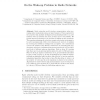Free Online Productivity Tools
i2Speak
i2Symbol
i2OCR
iTex2Img
iWeb2Print
iWeb2Shot
i2Type
iPdf2Split
iPdf2Merge
i2Bopomofo
i2Arabic
i2Style
i2Image
i2PDF
iLatex2Rtf
Sci2ools
90
Voted
ICALP
2005
Springer
2005
Springer
On the Wake-Up Problem in Radio Networks
Abstract. Radio networks model wireless communication when processing units communicate using one wave frequency. This is captured by the property that multiple messages arriving simultaneously to a node interfere with one another and none of them can be read reliably. We present improved solutions to the problem of waking up such a network. This requires activating all nodes in a scenario when some nodes start to be active spontaneously, while every sleeping node needs to be awaken by receiving successfully a message from a neighbor. Our contributions concern the existence and efficient construction of universal radio synchronizers, which are combinatorial structures introduced in [6] as building blocks of efficient wake-up algorithms. First we show by counting that there are (n, g)-universal synchronizers for g(k) = O(k log k log n). Next we show an explicit construction of (n, g)-universal-synchronizers for g(k) = O(k2 polylog n). By way of applications, we obtain an existential wak...
Efficient Wake-up Algorithms | ICALP 2005 | Polylog N | Theoretical Computer Science | Wake-up Algorithm |
Related Content
| Added | 27 Jun 2010 |
| Updated | 27 Jun 2010 |
| Type | Conference |
| Year | 2005 |
| Where | ICALP |
| Authors | Bogdan S. Chlebus, Leszek Gasieniec, Dariusz R. Kowalski, Tomasz Radzik |
Comments (0)

